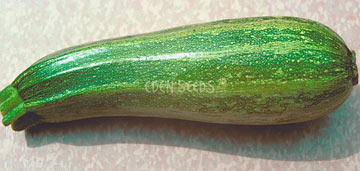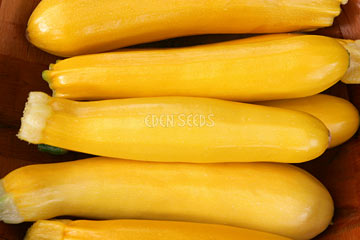Gardening Articles
Growing Zucchini
By Penny Ossowski
Zucchini, cucurbita pepo, is a member of the Cucurbitaceae family and therefore closely related to pumpkins, cucumbers, chokos, cucumbers, squash and gourds. Some of these are climbers, others are bush type plants but all do well in the warmer months of the year.
The zucchinis are also known as courgettes, marrows or summer squash. The earliest zucchini was brought from the Americas by early explorers and over many generations of growing in Italy developed/mutated into the modern day zucchini. In Australia, the United States and the English part of Canada it is call the Zucchini, while in New Zealand, France and other parts of Canada it is a Courgette. The name ‘zucchin’ comes from the Italian word ‘zucca’ which means squash, the male plural of which is’zucchini’. In France ‘courgette’ comes from the ‘courge’ meaning squash. The zucchini appears to have been first recorded in the United States in the early 1900’s and was brought to Australia by early migrants. In recent years the zucchini has become more popular in Australia.
The zucchini is such a versatile vegetable tasting delicious served raw in salads or cooked by stir frying, steaming, grilling, roasting and used in quiches, muffins, soups, casseroles, kebabs, fritters and delightful cooked with tomatoes, garlic and onions. Larger ones can be stuffed with meat, cheese, vegetables and herbs. Don’t forget the zucchini flowers, you can cook them too. Use firm fresh flowers with the pistils/stamens removed, dip in batter and deep fry or stuff and bake, even great in soups. Zucchini only store well for a few days in the refrigerator.
Now is the time to plant your zucchini seeds. Zucchinis will grow in many soil types, pH 6.0 – 7.5, but prefer their soil to have plenty of broken down compost and manure and add a little lime to avoid blossom end rot and some blood and bone. The location where you plant your zucchini should be in full sun for most of the day and well drained. Plants can grow up to a metre wide so allow plenty of space for good air circulation. Zucchinis not only come in a variety of colours but also in bush and vine varieties. Zucchinis can be planted direct into the soil or into a seed tray. I prefer to plant them directly into the soil and thin the seedlings if necessary when they have their first 2 proper leaves. If your soil is not well drained you should plant seeds into mounds. Plant 4 seeds in the top of each mound (thinning later to 2), shaping the top to look like a saucer so it will allow water to soak down near the roots. Sow seeds twice their own depth. Fertilise growing plants regularly with liquid fertilisers such as comfrey, compost or manure tea, seaweed or fish emulsion. Mulch well to retain moisture and keep fruit off the ground. Zucchini need to be well watered when the plants are growing and setting fruit, but water at the base of the plant not on the leaves. Bush type zucchini can be grown in large pots.
If bees are scarce in your garden it may be necessary to hand pollinate the flowers. The female flower has a small zucchini fruit behind the flower while the male has a uniform diameter stem. It is usual to have mainly male flowers early and more female flowers as time goes by. To hand pollinate pick a male flower, remove the petals and brush the pollen laden stamen across the pistil of the female flower. Encourage bees to your garden by growing flowering plants, ornamentals or herbs, nearby.
If your pollination is successful it will be only a matter of days before you are harvesting your first zucchini, you can just about watch the zucchini grow. Harvest zucchinis from about 15cm long up to 20 – 25cm. For stuffing some varieties will stay edible when longer but many become bitter and fibrous when allowed to grow too large. Did you see the large one Paul brought to the November meeting (about 60cm long and weighing 4.6kg)? Harvest by cutting the stem just above the fruit with a knife.
Zucchinis are susceptible to powdery or downey mildew. Watch out for early signs of small white powdery patches on the underside of the leaves (powdery mildew) or small, palish yellow areas on leaves slowly becoming brown (downy mildew) and spray regularly with either milk spray or wettable sulphur spray, don’t water the leaves and allow plenty of air circulation around the plants. Pests which attack zucchinis are aphids, pumpkin beetles, the cucumber fly, leaf eating ladybird and green vegetable bug. These are mainly troublesome when the plants are small and/or undernourished. You could try an organic spray, but I prefer just giving the plant a strong hosing as soon as a problem arises. If the fruits develop blossom end rot they are either not being watered regularly or next season add a little lime when preparing your soil.
Some popular varieties of zucchini seed which can be purchased on the Eden Seeds online store include

Trombocino -
Italian heirloom, climbing vine, more a squash then a zucchini, grow to a metre or more long very quickly
Cocozelle -
heirloom Italian, fine flavoured long smooth ridged fruit to 20cm, dark green with light stripes, bush plant, popular home or market variety
Rondo de Nice -
small round, medium green mottled yellow, exceptional flavour, skin bruises easily, prolific bearing

Lebanese -
Light green, sweet fruits, excellent flavour
Black Beauty -
Early bearing, uniform dark green, fine quality, bush type
Golden -
Medium long cylindrical shape, bushy plant
Rondo de Nice -
Small round, medium green mottled yellow, exceptional flavour
Golden Arch Crookneck -
yellow, attractive arched neck
Costa Romanesque -
heirloom Italian, bush zucchini, ribbed fruit, tender even when large
Nutritional Information
Serving Size: (100 grams raw)
Calories: 6 Kilojoules: 25.2
Total Fat: 0g Cholesterol: 0mg
Total Carbohydrates: 3g Dietary Fibre: 1g
Sugars: 2g Sodium: 10mg
Protein: 1g Calcium: 15mg
Folate: 29mcg Iron: 0.35mg
Magnesium: 17mg Manganese: .175mg
Niacin: 0.487mg Phosphorous: 38mg
Thiamin: 0.048mg Riboflavin: 0.142
Potassium: 262mg Vitamin B6: 0.218mg
Vitamin C: 17mg Vitamin E: .12mg
Vitamin K: 4.3mcg Zinc: 0.29mg
Zucchini Fritters
1 large zucchini, grated or finely chopped 1 small onion, chopped 1 tbsp chopped parsley
½ cup grated cheese (your choice) 1 clove garlic, chopped 3 eggs, beaten
1 cup milk 2 cups plain flour salt and pepper to taste
Olive oil
In a large bowl, mix together the zucchini, onion, garlic, eggs, cheese, parsley, milk, and flour, season with salt and pepper.
Heat oil in a large fry pan over medium heat. Drop tablespoons of the batter into the fry pan, and flatten slightly with the back of a spatula. Turn fritters over when the centre appears cooked. Cook on the other side until golden brown. Set aside and keep warm. Add more oil to pan as needed, and continue with remaining batter.



